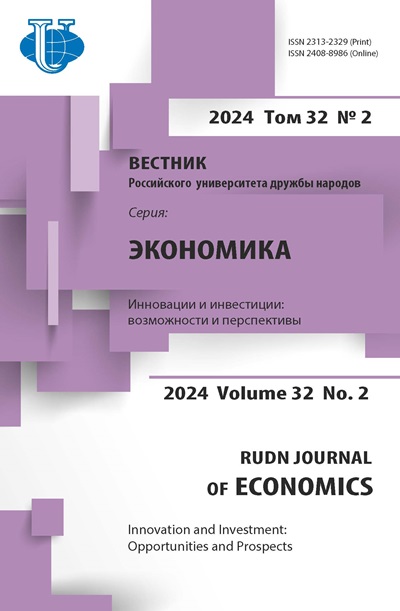Пандемия ВИЧ/СПИДа и сельскохозяйственное производство в Камеруне
- Авторы: Тамби М.Д.1
-
Учреждения:
- Университет Джанга
- Выпуск: Том 27, № 1 (2019)
- Страницы: 72-89
- Раздел: ЭКОНОМИКА ОТРАСЛЕВЫХ РЫНКОВ
- URL: https://journals.rudn.ru/economics/article/view/21302
- DOI: https://doi.org/10.22363/2313-2329-2019-27-1-72-89
Цитировать
Полный текст
Аннотация
В статье рассматривается степень влияния уровня распространения ВИЧ и СПИДа на сельскохозяйственное производство в Камеруне. Целью исследования является оценка факторов, влияющих на распространенность ВИЧ/СПИДа, а также изучение влияния ВИЧ/ СПИДа на сельскохозяйственное производство в Камеруне. В качестве основного источника информации взяты данные по обследованию потребления домашних хозяйств 2007 г., а также статистические данные профильных министерств, отвечающих за здравоохранение и сельское хозяйство в Камеруне. Основные результаты исследования получены путем применения двухэтапного метода регрессии наименьших квадратов. Результат исследования показал, что распространенность пандемии ВИЧ/СПИДа в Камеруне сильно зависит от уровня образования, возраста, профессии и экологических характеристик. В то же время данный метод продемонстрировал, что распространенность ВИЧ/СПИДа отрицательно коррелирует с сельскохозяйственным производством. Важность данных результатов определяется необходимостью совершенствования государственной сельскохозяйственной политики Камеруна с целью снижения негативного эффекта для системы здравоохранения и сельскохозяйственного комплекса страны.
Ключевые слова
Об авторах
Мбу Даниэль Тамби
Университет Джанга
Автор, ответственный за переписку.
Email: tambi2015@yahoo.co.uk
факультет экономики сельского хозяйства, Университет Дшанг, Камерун
Камерун, Джанг, Боит Постале, 96Список литературы
- Agbor E., Tambi D. (2014). Determinants of the HIV/AIDS epidemics prevalence in Cameroon. International Journal of Research and Review, 1(2), 8-19.
- Angrist J. (2001). Estimation of Limited Dependent Variable Models with Dummy Endogenous Regressors: Simple Strategies for Empirical Practice. Journal of Business and Economics Statistics, 19(1).
- Bascle G. (2008). Controlling for Endogeneity with Instrumental Variables in Strategic Management Research. Strategic Organization, 6(3), 285-327.
- Becker G. (1965). A theory of the allocation of time. The Economic Journal, 75(299), 493-517.
- Blau D., Grossberg T. (1990). Maternal Labor Supply and Children’s Cognitive Development. The Review of Economics and Statistics, (74), 474-481.
- Booysen F., Geldenhuys J., Marinkov M. (2003). The Impact of HIV/AIDS on the South African Economy: A Review of Current Evidence. TIPS/DPRU conference on “The Challenge of Growth and Poverty; the South African economy since democracy”.
- Dawn C., Kathryn H., Maction K. (2009). A Qualitative Study of the Impact of HIV/AIDS on Agricultural Households in Southeastern Uganda. International Journal Environ Respublic Health, 6(8), 2113-2138.
- Dow W. (1999). Flexible Discrete Choice Demand Models Consistent with Utility Maximization: An Application to Health Care Demand. American Journal of Agricultural Economics, 81(3), 680-685.
- FAO. (2002). The Impact of HIV/AIDS on rural households and land issues in Southern and Northern Africa. Economic and Social Development Department, Food and Agricultuiral Organisation, Corporate Document Repository.
- Hamusimbi C., Mataa M., Jere G. (2006). Impact of HIV and AIDS on agriculture and food security in SADC: The case of Zambia; Food. Agriculture and Natural Resources Policy Analysis network.
- Hofferth S.L. (1996). Effects of Public and Private Policies on Working after Childbirth. Work and Occupations, 23(4), 378-404. doi: 10.1177/0730888496023004004
- Joesch J. (1997). Paid leave and the timing of women’s employment before and after birth. Journal of marriage and the family, (59), 1008-1021.
- Jones C. (2007). Why Have Health Expenditures as a Share of GDP Risen So Much? U.C. Berkeley.
- Ilinigumugabo A. (1996). The economic consequences of AIDS in Africa. African Journal of Fertility, Sexuality and Reproductive Health, 1(2), 153-161.
- Isaksen J., Songstad N., Spissoy A. (2002). Socio-economic effects of HIV/AIDS in African countries. Chr. Michelsen Institute.
- Kormawa A. (2013). Impact of HIV/AIDS on African Agriculture and the role of the Consultative Group on Agricultural Research. Africa Rice Center (WARDA), B.P. 2031 Cotonou, Benin.
- Leibowitz A., Klerman J. (1995). Explaining changes in married mothers’ employment over time. Demography, 32(3), 365-378.
- Morrill S. (January 11, 2008). The Effects of Maternal Employment on the Health of School-Age Children. Job Market Paper. University of Maryland, College Park.
- Murray C. (2006). Avoiding Invalid Instruments and Coping with Weak Instruments. Journal of Economic Perspectives, 20(4), 111-132.
- Mwabu G. (2009). The Production of Child Health in Kenya: A Structural Model of Birth Weight. Journal of African Economies, 18(2), 212-260.
- Ndirangu L., Kimalu P. (2012). The Effects of HIV/AIDS on Agricultural Production and Poverty in Kenya. IDEAS at the Research Division of the Federal Reserve Bank of St. Louis using RePEc data. http://purl.umn.edu/9538
- Scicchitano J., Whitlock R. (2002). Quantifying the Effects of HIV/AIDS On Agricultural Production: A Guide From Rural Burkina Faso. Danish International Development Agency.
- Stover J., Bollinger L. (March 1999). The Economic Impact of AIDS. The Futures Group International in collaboration with: Research Triangle Institute, The Centre for Development and Population Activities.
- Tambi D.M. (2014). Modeling the effects of Mother’s Age at first birth on child health at birth. Asian Journal of Economic Modelling, 2(1) 1-17.
- Topouzis D. (December, 2000). Measuring the impact of HIV/AIDS on the agricultural sector in Africa. Joint and Cosponsored Program on AIDS. Geneva: UNAIDS.
- UNAIDS Costs of Scaling HIV Programmes to a National Level for Sub-Saharan Africa. (April 2000). Draft report.
- United Nations. (2010). The Impact of AIDS. United Nations Department of Economic and Social Affairs. Population Division.















